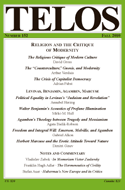From Telos 152 (Fall 2010), Arthur Versluis’s “The ‘Counterculture,’ Gnosis, and Modernity.” Read the full version at TELOS Online website.
Abstract
 Interpretations of the 1960s counterculture vary widely but often do not include discussion of its religious origins and significances. The counterculture represented the emergence into broader society of an essentially gnostic perspective, that is, a perspective that emphasizes above all not faith in a historical narrative promising a religious or secular millennium somewhere ahead, but direct individual spiritual insight here and now, as Theodore Roszak pointed out in his seminal The Making of the Counterculture. Some modern authors, in the vein of Eric Voegelin or Hans Blumenberg, exaggerate “Gnostic dualism” so as to make it into a bugaboo, thus masking the dualism inherent in Judaism, Christianity, and the dominant currents within secular modernity. But in fact, what we see in the late 1960s counterculture—informed by Buddhism and other non-dualist religious traditions—is an explicit emphasis on experience of non-duality. This gnostic tendency informs much of the counterculture. Such an observation should not be taken as a blanket valorization of the era, any more than it should be seen as a condemnation. In this article, Versluis explores the central role that gnosis and its rejection continue to play in Western history and now in secular modern society.
Interpretations of the 1960s counterculture vary widely but often do not include discussion of its religious origins and significances. The counterculture represented the emergence into broader society of an essentially gnostic perspective, that is, a perspective that emphasizes above all not faith in a historical narrative promising a religious or secular millennium somewhere ahead, but direct individual spiritual insight here and now, as Theodore Roszak pointed out in his seminal The Making of the Counterculture. Some modern authors, in the vein of Eric Voegelin or Hans Blumenberg, exaggerate “Gnostic dualism” so as to make it into a bugaboo, thus masking the dualism inherent in Judaism, Christianity, and the dominant currents within secular modernity. But in fact, what we see in the late 1960s counterculture—informed by Buddhism and other non-dualist religious traditions—is an explicit emphasis on experience of non-duality. This gnostic tendency informs much of the counterculture. Such an observation should not be taken as a blanket valorization of the era, any more than it should be seen as a condemnation. In this article, Versluis explores the central role that gnosis and its rejection continue to play in Western history and now in secular modern society.








